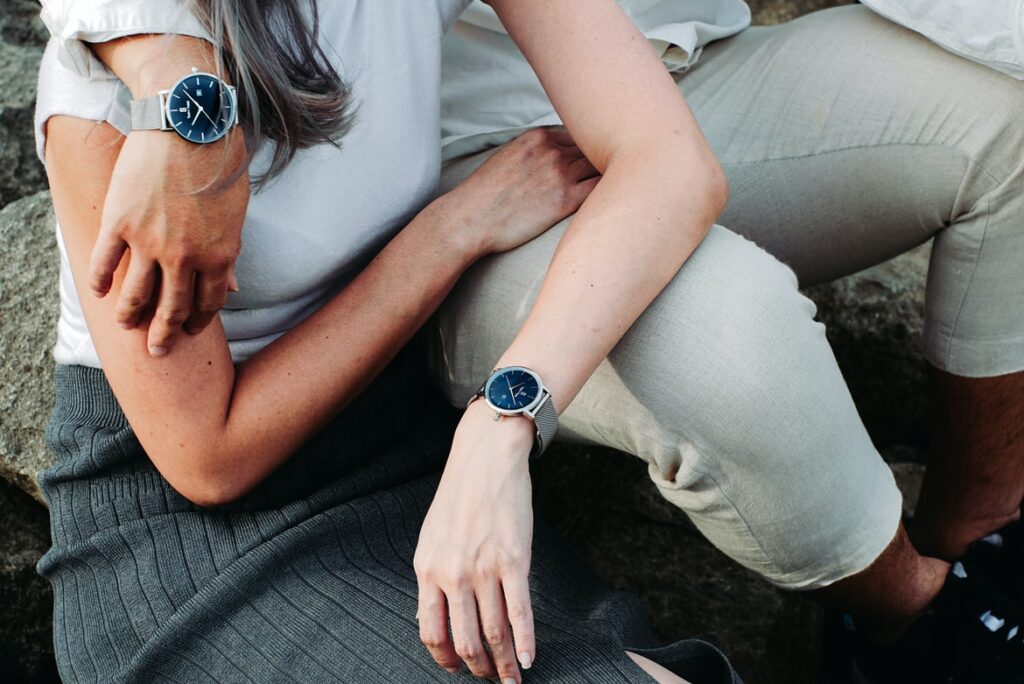The basic, functional need for watches has undeniably waned in recent years. Who needs a watch when a smartphone is always close to hand, after all?
However, here at IDEAL we’re still huge fans of timepieces worn in the traditional sense; faces, wrists, the works. While, of course, you can check your mobile phone for the time, doing so becomes a distraction, because let’s face it, our phones are a distraction.
Indeed, what was meant to be a quick glance at the time can easily become a Facebook conversation with your mum for an hour and an additional twenty minutes spent scrolling through social media.
Why not invest in a watch to save yourself time – literally, metaphorically, metaphysically, whatever – and you’ll notice that your day starts running more efficiently, too.
It seems that we’re not the only ones enamoured with the glory of proper timepieces. The lifestyle website Refinery29 reveals that, “since the pandemic took hold, consumers have begun investing in long-lasting, quality items”.
Moreover, they divulge that, “in 2021, the global fashion search engine Lyst has reported a 42% increase in searches for couple, engagement,and wedding watches”. It seems that watches are growing in popularity for all manners of reasons and occasions.
Whatever your reason for buying a watch, once you’ve decided to purchase a timepiece, there are a few things you need to consider. Luckily we’re here to help, with the help of The Watch Exchange London, here are 5 things to consider before investing in a watch.
Your Budget
The first thing you’ll want to do is nail down your price point. Firstly, there are high-end designer brands that everyone knows; think Cartier, Hermes and Rolex, which cost a pretty penny but are known for their craftsmanship and couture. These make for fine investment pieces, but are out of reach of most people’s budgets.
Luckily, there are lots of new, independent designers selling impressive timepieces in the region of £100, though you don’t necessarily even have to spend that much. If you’re after a digital watch, for instance, then the ever-cool Casio’s vintage design clocks in at around the £50 mark.
Another question is if you’d prefer a brand spanking new watch or a pre-owned yet still prestigious piece, or a more simple but fashionable watch found on the high street.
Currently, the pre-owned Swiss watch market is booming. Forbes points out that they are as environmentally friendly as they are stylish, smart and investment-savvy.
If you’re buying an investment timepiece like this, it’s important to do your homework and buy from a reputable auction house. There are fakes out there which are increasingly hard to spot, make no mistake.
Should the type of luxury watch you’re coveting feel completely out of reach, you could consider entering a watch competition. These are great opportunities to snag a luxury watch at a fraction of the retail price. There are both in-person and online watch competitions that offer a chance to win high-end watches from luxury brands. Just make sure to thoroughly research and verify the legitimacy of the competition before entering.

A Question Of Lifestyle
We’ve already said we’re fans of analogue watches but modern smart watches have a place, too. We love our smart watch at the gym and have found taking one out on a long walk, leaving our credit card at home and being able to buy a coffee with the tap of a watch immensely pleasurable.
If such small pleasures don’t resonate, then remember that buying a watch really depends on your lifestyle. Do you want something smart or something that looks more casual? If you’re looking for a mix of both, we adore Casio’s A700WMG-9AVT watch – part of the digital-vintage collection and straddling the link between dressy and casual perfectly; for a reasonable price, too.
Strap Or Bracelet
Do you prefer a watch with a strap or a bracelet?
The great thing about straps is that you can change them. Indeed, so many watch brands offer interchangeable watch straps that you can change at home, helping you switch up your outfit in tune (or should thay be ‘time’?) with your watch. T
he ease of being able to change the strap by yourself means that you can mix and match the straps with your outfits and your mood. You can also switch up the material of your strap depending on your mood, with the most common strap materials being leather, rubber and canvas.
Bracelets, on the other hand, are commonly made of metallic materials such as gold and stainless steel. They tend to look a little smarter than their strap counterparts.
The Shape Of You
News just in; watch cases aren’t only round or square. Yep, watches can come in all shapes and sizes, and represent a strong fashion statement when worn right.
There’s also rectangle watch faces and oval tonneau, which look like a barrel (and means barrel in French, too), as well as avant-garde shapes, which don’t really have a shape at all.
There’s even carré, which is a beautiful square, recognisable by its gently rounded corners. Or, how about a cushion shape, which some refer to as a ‘’squircle” shape, which are similar to carré faces, similar to oval shaped watches, but are horizontally oval on the wrist rather than vertical.
Yep, there’s a lot.
With all these shapes, it can be tricky picking one that suits your needs, lifestyle and wrist. Whilst it’s vital to buy a watch that you love the look of, first and foremost, if you’re indecisive, then let the shape of your wrist dictate your tastes.
For example, if you have small, dainty wrists, an oversized watch case may look like you’re a child playing dress up. However, a dainty watch on a large wrist may make your wrist look larger than it is, which you don’t want. Your best bet is to pop into a watch store and try on lots of different shapes to see which looks best.

Understand the Jargon
At watch-face value, the technical aspects of timepieces couldn’t be more simple. In fact, it’s designed to be just that; with even the most cursory of glances, you should be able to get all the information you need from your watch.
But when you dig a little deeper, the world of watches and watchmaking is a complex, often confusing affair, with a wide range of words that can feel like jargon to the uninitiated, particularly when time is of the essence and you don’t have time to whip out a dedicated dictionary when shopping for a watch. Moreover, if you aren’t familiar with the jargon, you may well be upsold a watch you simply don’t need.
There are so many technical, terminological aspects to consider, like do you want a watch with a dual timer or is it easier if it winds automatically. Do you want a rotating bezel or like the aesthetic of a day and night indicator? Do you want a deployment clasp? Is having an altimeter important to you? Do you want a watch with anadigi display features? Do you have any idea what we’re talking about?
Before you invest in a watch, it’s a good idea to understand all the terminology. Let us direct you to this very helpful article on the terminology of watches here.





